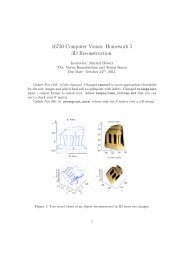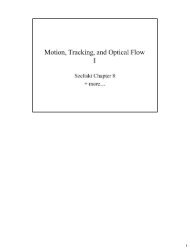16720: Computer Vision Homework 1
16720: Computer Vision Homework 1
16720: Computer Vision Homework 1
Create successful ePaper yourself
Turn your PDF publications into a flip-book with our unique Google optimized e-Paper software.
Instructions<br />
<strong>16720</strong>: <strong>Computer</strong> <strong>Vision</strong> <strong>Homework</strong> 1<br />
Instructor: Martial Hebert<br />
TAs: Varun Ramakrishna and Tomas Simon<br />
A complete homework submission consists of two parts. A pdf file with answers to the<br />
theory questions and the matlab files for the implementation portions of the homework.<br />
You should submit your completed homework by placing all your files in a directory<br />
named after your andrew id and upload it to your submission directory on Blackboard.<br />
The submission location is the same section where you downloaded your assignment. Do<br />
not include the handout materials in your submission.<br />
All questions marked with a Q require a submission. For the implementation part<br />
of the homework please stick to the function headers described.<br />
Final reminder: Start early! Start early! Start early!. MATLAB is a powerful<br />
and flexible language. It means you can do thins swiftly by a few lines of MATLAB<br />
code; it also means the program may go wrong without reporting any errors. Even for<br />
advanced MATLAB users, it is often the case that a whole day can be spent debugging.<br />
1 Homographies (25 points) (Varun)<br />
In class you have learnt that a homography is an invertible transformation between<br />
points on planes. The homography between planes is a powerful tool that finds use in a<br />
whole bunch of cool applications, some of which you will implement in this assignment.<br />
Let’s begin by exploring the concept of a homography in a little more detail.<br />
1.1 Definition and rank of a homography<br />
Consider two points p and q on planes Π1 and Π2. Let us assume that the homography<br />
that maps point p to q is given by S.<br />
Answer the following questions regarding S:<br />
Q1.1 What is the size (rows x columns) of the matrix S? 1<br />
Q1.2 What is the rank of the matrix S? Explain.<br />
1 Remember to use projective co-ordinates.<br />
p ≡ Sq (1)<br />
1
Q1.3 What is the minimum number of point correspondences (p,q) required to estimate<br />
S? Why?<br />
1.2 Homography between cameras<br />
Q1.4 Suppose we have two cameras C1 and C2 2 viewing a plane Π in 3D space. A<br />
3D point P on the plane Π is projected into the cameras resulting in 2D points u ≡<br />
(x1, y1, 1) and v ≡ (x2, y2, 1). Prove that there exists a homography between the points<br />
u and v.<br />
2 Panoramas (40 points) (Tomas)<br />
We can also use homographies to create a panorama image from multiple views of the<br />
same scene. This is possible for example when there is no camera translation between<br />
the views (e.g., only rotation about the camera center). In this case, corresponding<br />
points from two views of the same scene can be related by a homography 3 :<br />
p i 1 ≡ Hp i 2, (2)<br />
where p i 1 and pi 2 denote the homogeneous coordinates (e.g., pi 1 ≡ (x, y, 1)T ) of the 2D<br />
projection of the i-th point in images 1 and 2 respectively, and H is a 3 × 3 matrix<br />
representing the homography.<br />
2.1 Homography estimation<br />
Q2.1 Given N point correspondences and using (2), derive a set of 2N independent<br />
linear equations in the form Ah = b where h is a 9 × 1 vector containing the unknown<br />
entries of H. What are the expressions for A and b ? How many correspondences will<br />
we need to solve for h?<br />
Q2.2 Implement a function H2to1=computeH(p1, p2). Inputs: p1 and p2 should be<br />
2 x N matrices of corresponded (x, y) T coordinates between two images. Outputs: H<br />
should be a 3x3 matrix encoding the homography that best matches the linear equation<br />
derived above (in the least squares sense). Hint: Remember that H will only be<br />
determined up to scale, and the solution will involve an SVD.<br />
Q2.3 Implement a function H=computeH_norm(p1, p2). This version should normalize<br />
the coordinates p1 and p2 (e.g., from -1 to 1) prior to calling compute_H. Normalization<br />
improves numerical stability of the solution. Note that the resulting H should still follow<br />
Eq. (2). Hint: Express the normalization as a matrix.<br />
2 You can assume that the camera matrices of the two cameras are given by M1 and M2.<br />
3 For an intuition into this relation, consider the projection of point P i = (X, Y, Z) T into two views<br />
p i 1 ≡ KP i and p i 2 ≡ KRP i , where K is a (common) intrinsic parameter matrix, and R is a 3 × 3<br />
rotation matrix. In this case: p i 1 ≡ KR −1 K −1 p i 2.<br />
2
Q2.4 Select enough corresponding points from images taj[1, 2].png using for example<br />
Matlab’s cpselect. They should be reasonably accurate and cover as much of the<br />
images as possible. Use computeH_norm to relate the points in the two views, and plot<br />
image taj1.png with overlayed points p1 (drawn in red), and (drawn in green) points<br />
p2 transformed into the view from image 1 (call this variable p2_t). Save this figure<br />
as q2_4.jpg. Additionally, save these variables to q2_4.mat:<br />
H2to1=computeH_norm(p1,p2);<br />
...<br />
save q2_4.mat H2to1 p1 p2 p2_t;<br />
Write an expression for the average error (in pixels) between p1 and the transformed<br />
points p2. This expression should be in terms of H, p1, and p2. Compare this to the<br />
error that was minimized in items 1 and 2.<br />
2.2 Image warping<br />
The provided function warp_im=warpH(im, H, out_size) warps image im using the<br />
homography transform H. The pixels in warp_im are sampled at coordinates in the rectangle<br />
(1, 1) to (out_size(2), out_size(1)). The coordinates of the pixels in the source<br />
image are taken to be (1, 1) to (size(im,2), size(im,1)) and transformed according to<br />
H.<br />
The following code:<br />
H2to1=computeH_norm(p1,p2);<br />
warp_im=warpH(im2, H2to1, size(im1));<br />
should produce a warped image im2 in the reference frame of im1. Not all of im2 may<br />
be visible, and some pixels may not be drawn to.<br />
Figure 1: Original images and warped.<br />
(a) taj1.jpg (b) taj2.jpg (c) taj2 warped into taj1<br />
Q2.5 Write a few lines of Matlab code to find a matrix M, and out_size in terms of<br />
H2to1 and size(im1) and size(im2) such that,<br />
warp_im1=warpH(im1, M, out_size);<br />
warp_im2=warpH(im2, M*H2to1, out_size);<br />
3
produces images in a common reference frame where all points in im1 and im2 are<br />
visible (a mosaic or panorama image containing all views) and out_size(2)==1280.<br />
M should be scaling and translation only, and the resulting image should fit snugly<br />
around the transformed corners of the images.<br />
2.3 Image blending<br />
Figure 2: Final mosaic view.<br />
Q2.6 Use the functions above to produce a panorama or mosaic view of the two images,<br />
and show the result. Save this image as q2_7.jpg. For overlapping pixels, it<br />
is common to blend between the values of both images. You can simply average the<br />
values. Alternatively, you can obtain a blending value for each image:<br />
mask = zeros(size(im,1), size(im,2));<br />
mask(1,:) = 1; mask(end,:) = 1; mask(:,1) = 1; mask(:,end) = 1;<br />
mask = bwdist(mask, ’city’);<br />
mask = mask/max(mask(:));<br />
The function bwdist computes the distance transform of the binarized input image, so<br />
this mask will be zero at the borders and 1 at the center of the image.<br />
Q2.7 In items Q2.1−2.3 we solved for the 8 degrees of freedom of a homography. Given<br />
that the two views were taken from the same camera and involve only a rotation, how<br />
might you reduce the number of degrees of freedom that need to be estimated?<br />
QX1 (Extra Credit 10 points) Assume that the rotation between the cameras is<br />
only around the y axis. Using H2to1, and assuming 4 no skew and α = β = 1274.4,<br />
4 The previous notation used α = fx, β = fy, u0 = cx, v0 = cy, and no skew.<br />
4
u0 = 814.1, and v0 = 526.6, estimate the angle of rotation between the views. You<br />
should be able to approximate this with elementary trigonometry.<br />
2.4 Extra credit: Laplacian pyramid blending<br />
Linear blending produces ghosting artifacts when the scene changes between the views<br />
(e.g., the people in the example images). In these regions, we should take the pixels<br />
from only one image. Unfortunately, having hard seams between images often introduces<br />
noticeable discontinuities, as for example an abrupt change in the color of the sky.<br />
Laplacian blending alleviates this problem by blending features at different frequency<br />
bands.<br />
QX2 (Extra Credit 10 points) Implement laplacian pyramid blending for images.<br />
First construct a gaussian pyramid of each image and mask. Then, construct the laplacian<br />
pyramid using the difference of gaussians. Now blend each of the levels together<br />
with the corresponding mask, and reconstruct the image. Show your impressive results.<br />
Figure 3: An Annoying Clockwork Orange.<br />
(a) oranges.jpg (b) alex.jpg (c) mask.jpg<br />
(d) Gaussian and laplacian pyramids.<br />
5<br />
(e) Blended result, normal (top),<br />
and 5-level pyramid (bottom).
3 Camera Estimation (35 points) (Varun)<br />
In class we learnt that the camera matrix M can be decomposed into its intrinsic parameters<br />
given by the matrix K and extrinsic parameters given by the rotation R and<br />
translation t<br />
M = K [R t] (3)<br />
and the camera projection equation is given by:<br />
p ≡ MP (4)<br />
The rotation and translation of the camera is also commonly referred to as the pose<br />
of the camera. A problem that commonly arises in areas such as model-based object<br />
recognition, augmented reality and vision-based robot navigation is that of estimating<br />
the pose of the camera given 3D co-ordinates of points on an object/scene and their<br />
corresponding 2D projections in the image. In this question we shall explore the use of<br />
pose estimation in a problem that arises in motion capture.<br />
3.1 Problem Statement<br />
Given the locations of 3D optical markers placed at the joints of a human subject, and<br />
the corresponding locations of the markers in the image, estimate the pose of the camera<br />
relative to the human subject.<br />
Begin by loading the file hw1 prob3.mat into your matlab workspace. You will find<br />
two variables in your workspace:<br />
• xy - a 23 × 2 matrix of the 2D locations of the joints in the image<br />
• XYZ - a 23 × 3 matrix of the 3D locations of the joint markers in the scene.<br />
For this assignment the 2D image points and the 3D joint marker positions have<br />
been generated synthetically, we will first visualize our data (First rule of implementing<br />
a computer vision algorithm- visualize, visualize, visualize). You have been given two<br />
functions visualize2Dpoints and visualize3Dpoints 5 to help you with this.<br />
3.2 Estimating the camera<br />
Q3.1 Your primary task in this problem is to write the following function and answer<br />
the questions that follow:<br />
[R, t] = estimateCamera(xy, XYZ)<br />
5 Type ’help functionname’ in matlab to get information on usage.<br />
6
which takes as input the 23 × 2 matrix xy of 2D locations and the 23 × 3 matrix of<br />
3D locations XY and returns as output the rotation R and translation t of the camera<br />
in the object co-ordinate system. We will assume that the camera intrinsic parameter<br />
matrix K is given and is equal to the identity matrix.<br />
The camera matrix M that you estimated needs to be separated into a rotation R<br />
and a translation t.<br />
Q3.2 You could imagine simply taking the first 3 × 3 part of M to be the rotation of<br />
the camera. However, this would be incorrect, explain why.<br />
Q3.3 Under what condition is the 3 × 3 matrix a rotation matrix ?<br />
Q3.4 How can we convert the first 3 × 3 portion of the matrix M into a rotation<br />
matrix? 67<br />
Q3.5 Write the following function by making the change you derived in the previous<br />
question to correct the camera estimate<br />
[R,t] = estimateCamera2(xy, XYZ)<br />
3.3 Visualization<br />
Q3.6 Visualize the given 3D joint marker points using the provided visualize3Dpoints<br />
function and place the estimated camera in the scene using the provided drawCam<br />
function.<br />
3.4 Epilogue<br />
In this problem we have implemented a simple version of pose estimation which might<br />
not very stable for real applications. There are several current state of the art approaches<br />
for estimating the perspective camera pose from 2D-3D correspondences (also known as<br />
the Perspective-N-Points problem), such as in the following paper:<br />
EPnP: Accurate O(n) Solution to the PnP Problem - Francesc Moreno-<br />
Noguer, Vincent Lepetit, Pascal Fua. (IJCV 2008)<br />
Change log<br />
Sept. 11th: Revised grading scheme to be Problem 1: 25 points, Problem 2: 40 points,<br />
problem 3: 35 points.<br />
Sept. 11th: Changed notation in QX1 to match what was used in class.<br />
6 This estimate will actually be the best rotation in a least-squares sense.<br />
7 Hint: The solution uses an SVD.<br />
7
10<br />
5<br />
0<br />
−5<br />
−10<br />
−15<br />
0<br />
10<br />
20<br />
30<br />
40<br />
50<br />
4<br />
2<br />
0<br />
−2<br />
Figure 4: Human skeleton visualization with estimated camera position.<br />
8







